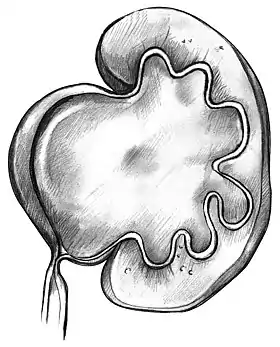Pyeloplasty
Pyeloplasty is performed to treat an uretero-pelvic junction obstruction if residual renal function is adequate.[1]
| Pyeloplasty | |
|---|---|
 Drawing of a swollen kidney that results from ureteropelvic junction obstruction | |
| Specialty | urologist |
This revision of the renal pelvis treats the obstruction by excising the stenotic area of the renal pelvis or uretero-pelvic junction and creating a more capacious conduit using the tissue of the remaining ureter and renal pelvis.
There are different types of pyeloplasty depending on the surgical technique and patterns of incision used. These include the Y-V, Inverted 'U', and Dismembered types of pyeloplasty. The dismembered type of pyeloplasty (called an Anderson-Hynes pyeloplasty) is the most common type of pyeloplasty. This was described in relation to retrocaval ureter (now renamed as preureteric vena cava). Another technique of pyeloplasty is Culp's pyeloplasty; in this method a flap is rotated from dilated pelvis to decrease narrowing of ureter.
A pyeloplasty can either be done by the robotic, open, or laparoscopic route.
References
- Smith, Arthur D. (2007). Smith's Textbook of Endourology. PMPH-USA. p. 109. ISBN 9781550093650. Retrieved 17 September 2018.